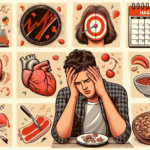Self-medication refers to the practice of individuals treating their ailments and conditions with pharmaceuticals or remedies without professional supervision. While this behavior can be convenient, it also carries significant risks, particularly in countries with high self-medication prevalence, such as India.
Epidemiology and Prevalence of Self-medication in India
The prevalence of self-medication in India is alarmingly high, reflecting a multifaceted issue that spans various demographics and regions. A study conducted in a rural area of Andhra Pradesh revealed that 68.1% of the population engaged in self-medication, with pharmacists being the primary source of medication (72.6%) and analgesics being the most commonly used drugs (Rangari, 2020).
Another study focusing on India’s urban population reported a self-medication prevalence rate of 11.9%, with males, individuals over 40 years of age, and those involved in moderate occupational activities being more likely to self-medicate. This disparity highlights the influence of socioeconomic and occupational factors on self-medication practices (Selvaraj, 2014).
In a Northern Indian rural town, 50% of the population admitted to self-medicating, primarily for common ailments such as headaches, fever, and urinary infections. This indicates a significant reliance on self-treatment for everyday health issues (Juneja, 2024).
University students in India also exhibit high self-medication rates. A systematic review and meta-analysis reported a prevalence of 70.1% among university students, showcasing a worrying trend of self-medication in younger, educated populations (Behzadifar, 2020). The incidence of self-medication in India has varied over the years, with estimates ranging from 31% in 1997 to 53.57% in 2020. These figures underscore the pervasive nature of self-medication and the evolving patterns influenced by accessibility, cultural beliefs, and economic factors (Fathima Johnbasha, 2022).
Factors Contributing to Self-Medication

In India, self-medication is driven by a multitude of factors that intertwine cultural, economic, and healthcare system dynamics. The ease of accessibility to medications plays a pivotal role. Many drugs, including antibiotics and painkillers, are readily available over-the-counter without a prescription. This situation is exacerbated by the proliferation of online pharmacies, which offer even wider and more convenient access to medications without the oversight of healthcare professionals.
Economic constraints significantly contribute to the self-medication trend. For many individuals, especially in rural or underserved urban areas, the cost of consulting a healthcare professional is prohibitive. Medical consultations, diagnostic tests, and prescribed treatments often represent a financial burden that many are unable to bear. Consequently, people resort to self-medication as a cost-saving measure.
Time constraints also play a critical role. Busy lifestyles and long waiting times at clinics and hospitals deter individuals from seeking professional medical advice. Instead, they opt for the quicker route of self-diagnosis and self-treatment.
Educational and awareness levels further complicate the scenario. A lack of understanding about the potential dangers of improper medication use, coupled with misinformation from non-medical sources, can lead people to underestimate the risks. Additionally, cultural beliefs and traditional practices often encourage the use of home remedies and over-the-counter medications as first-line treatments.
The influence of media and pharmaceutical marketing cannot be overlooked. Aggressive marketing strategies by pharmaceutical companies can mislead consumers into believing that certain medications are safe for use without professional guidance. This is particularly concerning with advertisements promoting the benefits of drugs while downplaying or omitting potential risks.
Potential Harms of Self-Medication

Self-medication, while seemingly convenient, harbors numerous risks that can have serious health implications.
One of the foremost concerns is the development of antimicrobial resistance (AMR). Inappropriate use of antibiotics, such as incorrect dosages or incomplete courses, can lead to the survival of resistant bacteria. These resistant strains can then spread, rendering standard treatments ineffective and posing a severe threat to public health. This issue is particularly acute in India, where antibiotic misuse is rampant.
Adverse drug reactions (ADRs) are another significant risk. Without professional guidance, individuals may use medications that are contraindicated for their specific health conditions, leading to harmful side effects. For example, non-steroidal anti-inflammatory drugs (NSAIDs) used for pain relief can cause gastrointestinal bleeding or kidney damage if used improperly. Additionally, drug interactions are a serious concern, as individuals self-medicating may unknowingly combine medications that interact negatively.
Self-medication can also mask the symptoms of more serious underlying conditions. Treating symptoms like headaches or stomach pain with over-the-counter medications can delay the diagnosis of conditions such as migraines, gastrointestinal disorders, or even malignancies. This delay can lead to a progression of the disease and complicate treatment outcomes.
Dependence and abuse represent further potential harm. The availability of medications like opioids and sedatives without proper medical supervision can lead to substance abuse and addiction. This not only affects the individual’s health but also has broader social and economic repercussions.
Furthermore, there is the issue of incorrect self-diagnosis. Without proper medical training, individuals may misinterpret symptoms and use the wrong medication. This can exacerbate the condition or lead to new health issues. For instance, using antibiotics for viral infections like the common cold or flu is ineffective and contributes to unnecessary side effects and resistance.
Professional and Regulatory Recommendations

A comprehensive approach encompassing education, regulation, and healthcare system reforms is imperative to mitigate the risks associated with self-medication. One of the most effective strategies is the implementation of extensive education and awareness campaigns. These campaigns should aim to inform the public about the dangers of self-medication and the importance of consulting healthcare professionals. Such initiatives can be spearheaded by government bodies, healthcare institutions, and non-governmental organizations, utilizing various media platforms to reach a broad audience.
Stricter regulations on the sale of medications are crucial. Enforcing prescription-only policies for certain classes of drugs, particularly antibiotics and psychotropic substances, can significantly reduce misuse. This includes stringent monitoring of online pharmacies to ensure compliance with regulations. Regulatory bodies must enhance surveillance and penalize violations to deter the unauthorized sale of medications.
Pharmacovigilance programs need to be strengthened to monitor adverse drug reactions and misuse patterns. Establishing robust pharmacovigilance systems can help in the early detection of issues related to self-medication and facilitate timely interventions. These programs should be integrated into the healthcare system, with healthcare professionals encouraged to report any cases of adverse reactions or misuse they encounter.
Healthcare system reforms are also essential. Improving access to healthcare services, particularly in rural and underserved areas, can reduce the reliance on self-medication. This includes increasing the availability of affordable and timely medical consultations, diagnostic services, and treatments. Mobile health units and telemedicine services can bridge the gap in areas with limited healthcare infrastructure.
Training healthcare professionals to provide better patient education on medication use is another critical step. Pharmacists, in particular, can play a key role in educating patients about the appropriate use of medications and the potential risks of self-medication. Encouraging pharmacists to act as gatekeepers and ensure that medications are dispensed responsibly can also help curb misuse.
Collaboration between government agencies, healthcare providers, and the pharmaceutical industry is essential to develop and enforce policies aimed at reducing self-medication. This includes creating guidelines for the ethical marketing of medications and ensuring that pharmaceutical companies adhere to these standards.
While self-medication can offer convenience, the potential harms far outweigh the benefits. In India, the high prevalence of self-medication is a significant public health concern that requires urgent attention from healthcare professionals and policymakers to mitigate risks and promote safe medication practices.
References:
- Rathod P, Sharma S, Ukey U, et al. Prevalence, Pattern, and Reasons for Self-Medication: A Community-Based Cross-Sectional Study From Central India. Cureus. 2023;15(1):e33917.
- Bennadi D. Self-medication: A current challenge. J Basic Clin Pharm. 2013;5(1):19-23.
- Wikipedia. Self-medication. Available from: [https://en.wikipedia.org/wiki/Self-medication](https://en.wikipedia.org/wiki/Self-medication)
- Rangari, Gaurav M.1; Bhaisare, Roza G.2,; Korukonda, Venkatasandhya3; Chaitanya, Y Lakshmi3; N, Hanumanth4. Prevalence of self-medication in rural area of Andhra Pradesh. Journal of Family Medicine and Primary Care 9(6):p 2891-2898, June 2020.
- Selvaraj K, Kumar SG, Ramalingam A. Prevalence of self-medication practices and its associated factors in Urban Puducherry, India. Perspect Clin Res. 2014;5(1):32-36.
- Juneja K, Chauhan A, Shree T, et al. Self-medication prevalence and associated factors among adult population in Northern India: A community-based cross-sectional study. SAGE Open Medicine. 2024;12.
- Behzadifar M, Behzadifar M, Aryankhesal A, et al. Prevalence of self-medication in university students: systematic review and meta-analysis. East Mediterr Health J. 2020;26(7):846-857. Published 2020 Jul 23.
- Fathima Johnbasha A, Tamilchelvan V, Kumar S. Prevalence of Self-medication Practices and Their Associated Factors in Puducherry, India: A Cross-sectional Study. J Research Health 2022; 12 (5):291-296.


